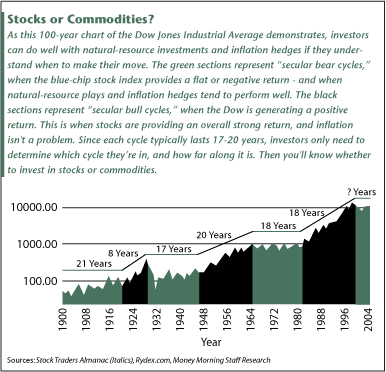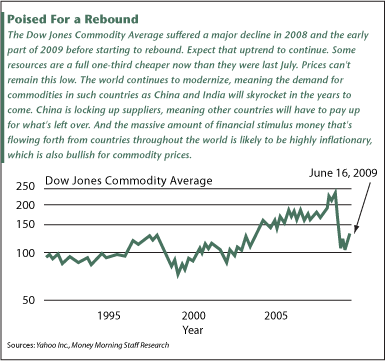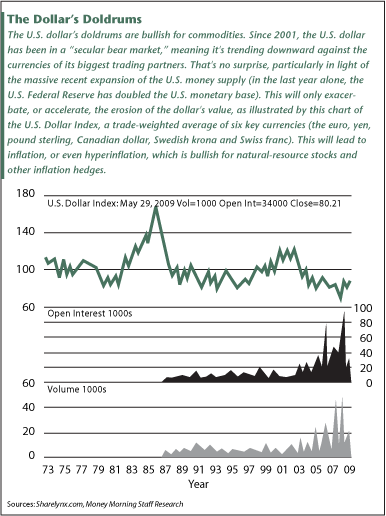The Secret to Commodity Investing Profits
Commodities / Investing 2009 Jul 09, 2009 - 05:06 AM GMTBy: Money_Morning
 Peter Krauth writes: There has never been a better time to invest in commodities.
Peter Krauth writes: There has never been a better time to invest in commodities.
That’s a very simple statement, but it’s backed by three powerful points:
- Commodities tend to do well when more-popular investments (with retail investors) are doing poorly, and when economic conditions are less than ideal.
- When the typical economic underpinnings are at play, a “Secular Bull Market” for commodities tends to last for about 17 years. And right now, the underpinnings are far from typical - and may even be exemplary, meaning this bull-market run could last a lot longer than the norm.
- And last, but not least, we’re only about nine years into this commodities bull market, meaning there’s probably a lot more room to run - probably eight years, and very like even more.
Amazingly, this powerful notion of the “Secular Market Cycle” - despite its tremendous profit potential - is largely unknown to the investment masses, and is rarely discussed by the mainstream business news media. Indeed, it’s so taken for granted that it almost a market secret.
If you’re a long-term investor, however, you’ll ultimately realize it’s one of the most lucrative strategies you have in your investing arsenal. And most amazing of all is that it’s easy to understand, easy to deploy, and easy to profit from.
Let me explain.
The Secret of the Secular Market Cycle
Why is it so special? Well, with a finite time to invest for your retirement, it’s crucial to recognize and understand what we like to refer to as the “Secular Market Cycle,” or “Secular Cycle,” for short.
As the chart shows, a Secular Cycle, from peak to trough, typically lasts about 17-20 years on average (the period depicted by the chart ends in 2004, but still perfectly illustrates our concept). And there are essentially two types of cycles:
- The “Secular Bull Cycle,” during which regular stocks increase in value, and have their Price/Earnings (P/E) ratios (earnings multiples) expand. That means that stocks get more expensive.
- And the “Secular Bear Cycle,” during which stocks tend to experience a decline in both price and valuation, with P/Es that contract. At best, stock prices move sideways over an extended period, but still see their P/E multiples shrink, since corporate earnings are growing at a time when stock prices are stagnant.
For investors, one key problem is that an overall “Secular Cycle,” from trough to peak, and back to trough, can take 35 years. That’s a big chunk of a person’s wage-earning years, meaning there’s little room for missteps.
Now, there’s no point in fighting a secular market trend - not if you want your investments to grow.

So it’s essential to determine where we are in the cycle, because that will dictate expected returns over the following decade or two. And since most people only spend about 40 years of their lives investing for retirement, not knowing about the “Secular Cycle” - much less where we are right now in the cycle - leads to guesswork, mistakes and losses, instead of the clear planning that will generate the best investment decisions and, ultimately, the biggest profits.
But in order to see where we are, we need to figure out where we’ve been. To do that, let’s take a look at a very-long-term chart of the stock market in order to study the historic market trends. Then we’ll look at some other key factors - such as the value of the U.S dollar - to confirm our analysis. This is a process few investors take the time to work through.
Where are we right now? Well, since about 2000, we’ve clearly entered a Secular Bear Market for general stocks.
All too often, investors read such a statement and conclude that its “game over” for portfolio profits. And that’s just not the case.
There’s an old market adage that says “there’s always a bull market somewhere.” That’s true even today, in the midst of the worst financial crisis since the Great Depression. Even if there’s a Secular Bear Market for stocks, it’s very likely that you’ll find a Secular Bull Market for commodities. So all you really need to do is to focus your investing efforts on the hard-asset sectors.
The Makings of a Secular Commodity Cycle
The last commodity cycle ended around 1980. Essentially, a prolonged period of high commodity prices encouraged producers to over-develop their resources. Demand never fell off. Instead, there was a massive oversupply, and the commodities party eventually ended. Prices got pushed off a cliff, so the entire sector became lean in a hurry as profit margins imploded.
As you’ve probably guessed, exploration soon ground to a halt. And little or no money was invested to expand production. Over the next two decades, investors rejected hard assets.
Over time, known resource reserves were continuously plundered, and finally gave out about nine years ago. At about the same time, the Four Asian Tigers of Korea, Taiwan, Hong Kong and Singapore were already building a gargantuan appetite, and China’s big growth spurt was gaining momentum and growing in magnitude.
The situation has only gotten worse, with global commodities demand continuing to advance - even in the face of sapped inventories.
The Three Catalysts for Major Commodity Profits
We now know that a typical Secular Bull or Bear market will last 17-20 years. We also now know that the last Secular Commodity Bull was launched roughly around 2000. That allows us to conclude that we’ve easily got between eight and 11 years to go before supply catches up with the burgeoning global demand that we’re seeing right now.
Yet according to such renowned market experts as author and investing icon Jim Rogers, a number of “wild cards” are in place this time around, meaning this bull market in commodities may have a lot more room to run than its more-typical predecessors. Three factors in particular are extremely bullish for commodities investors:
- Global Infrastructure Spending: The Organization for Economic Cooperation and Development (OECD) last year estimated that worldwide investments in power-generation, water and transportation infrastructure projects would exceed $40 trillion by 2030 - and that was before countries around the world enacted hundreds of billions of dollars in stimulus-spending programs.
- Improving Worldwide Living Standards: About half the world’s 6.7 billion inhabitants are simultaneously pushing to improve their living standards, a fact that by itself stands to create a commodities demand shock never before seen - enough by itself, in fact, to extend the secular commodities bull by five additional years.
- Modernization Efforts in Major Markets: The modernization initiatives in China, India, Brazil, Eastern Europe and other portions of Asia are extremely bullish for commodities prices.
So if you’re looking for a place to stash your cash for the next 12-15 years, look no further: Commodities are the key profit play to make.
Two Arguments Against Low Current Prices
Unless you’re Rip Van Winkle, or had taken up residence in Biosphere 2, you know that the global financial markets suffered through a panic sell-off, and that we’re mired in one of the worst economic downturns in decades.
We also know that many investors sought refuge in U.S. Treasury securities. In order to buy Treasuries, investors throughout the world first bought U.S. dollars, driving up their value in relation to virtually every other major currency. That anomalous and unsustainable U.S. dollar spike hurt commodities, as they are all priced in terms of dollars.
The fear of a deep worldwide recession - or perhaps even a depression - served to temporarily frighten investors out of commodity plays, since the prevailing wisdom was that the global malaise would cause demand for natural resources to plunge. That, too, dampened commodity prices.
But investors who right now fear commodity plays are looking at this from the wrong vantage point: Instead of representing a dangerous point, the situation now at hand is nothing less than an extraordinary opportunity to either make their first foray into commodities, or to add to existing positions during periods of exceptional weakness.
What investors need to understand is that - in the last seven months or so - they have been witness to an impressively quick and coordinated adjustment on the part of commodity producers. No time was wasted to pull the plug on unprofitable production, suspend near-term new production, or slash capital spending or investments in all forms of exploration.

Right now, most commodities producers are operating with little or no spare capacity. The fat’s been trimmed, and prices are down a third from this time last year.
It’s a situation that just can’t last - for two very simple reasons:
- First, world demand can’t be reversed on a dime. At least half the world continues to move forward with modernization initiatives. Massive infrastructure efforts continue unabated. And governments from both developed and developing nations are ensuring that this infrastructure-modernization train doesn’t get derailed.
- Second, central governments have recently put on a show of unprecedented fiscal cooperation, unveiling colossal bailout and spending plans. The United States ($787 billion) and China ($586 billion) alone have unveiled stimulus packages worth a combined $1.37 trillion. The addition of all that newly printed money means there are even more dollars chasing a still-fixed quantity of goods. And that can lead to only one outcome: A big increase in commodities prices.
We’ve become used to seeing prices increase. Price increases are merely a fact of life. That’s why we see pay raises each year; we’re trying to compensate for the prices that are rising all around us.

But the magnitude of recent money-supply increases dwarfs the benign, garden-variety annual price increases of 3% to 6% that we’ve grown used to seeing. In the last year alone, the U.S. Federal Reserve has actually doubled the U.S. monetary base. That can only lead to serious inflation, perhaps even hyperinflation. This will cause the value of the U.S. dollar - which has been eroding since 2001 - to decline at an even-more-frenetic pace. Over time, in turn, this erosion in the value of the dollar will lead to a big increase in the prices of many goods, particularly commodities imported from abroad.
That’s yet another reason why investors must consider resources of all kinds.
Profit Plays to Consider Now
With class now over, it’s time to put your newfound insights to work, searching out ways to earn the outsized profits that will be available from the Secular Bull Market in commodities.
If you want an automatically diversified approach, check out the various resource sector mutual funds available to you. That can be a great starting point. Make sure to look at each fund’s individual holdings, which will give you a feel for that fund’s focus, and that will also help you get more familiar with the individual companies and what they do.
If you prefer individual stocks, you have to get to know BHP Billiton Ltd. (NYSE ADR: BHP). This $140 billion resources behemoth is the largest diversified mining company on earth. With an enviable balance sheet and cash flow, this producer of base metals, precious metals, diamonds and energy is way ahead of the pack. With a current P/E of 11.66, the stock isn’t bargain basement cheap, but it still represents a good value. Besides, this is a stock that you’ll want to hold all the way to the very end of the
Secular Cycle.
Exchange-traded funds (ETFs) and exchange-traded notes (ETNs), on the other hand, provide investors with a more-direct exposure to commodity prices, as opposed to exposure to the stocks of the commodity-producing companies.
The broadest exposure you can get is probably through the ELEMENTS Rogers International Commodity Index Total Return ETN (NYSE: RJI). RJI, based on the index built by the investing-guru Rogers, himself, is comprised of 34.9% agriculture, 21.1% metals, and 44% energy. Another viable option is the PowerShares DB Commodity Index Fund (NYSE: DBC). While less diversified - with 22.5% agriculture, 22.5% metals, and 55% energy - it boasts large trading volume.
You can also get exposure through some of the ETFs that focus individually on agriculture, coal, nuclear power, and steel-related companies. Van Eck’s Market Vectors’ suite of ETFs - such as its Market Vectors Agribusiness ETF (NYSE: MOO) - is a great place to start.
Finally, you’d be wise to get some gold exposure too. Gold miners could be an excellent hedge against the enormous inflationary pressures that Money Morning has repeatedly warned investors to expect. In this case, the Market Vectors Gold Miners ETF (NYSE: GDX) - composed chiefly of major gold miners - offers both company and geographical diversification, while including substantial leverage to the price of gold. GDX is based on the AMEX Gold BUGS Index (HUI), which represents a portfolio of 15 major gold mining companies that do not hedge their gold production beyond a year and a half.
The bottom line: As you go about rebalancing your portfolio - or continue rebuilding it as a result of the financial-crisis carnage - make sure to include room for a solid natural resources allocation.
In the next couple of years, as U.S. and overseas economies recover, commodities producers will pay the price for recent major cuts in production, development and exploration - discovering it will be very tough to boost output even as global demand soars.
Shrewd investors will reap the benefit of those decisions: Those shortages will persist, providing quite a tailwind for soaring prices.
Just make sure that your sails are fully deployed.
The bottom line: As you go about rebalancing your portfolio - or continue rebuilding it as a result of the financial-crisis carnage - make sure to include room for a solid natural resources allocation.
[Editor's Note: If you're new to the commodities-investing arena, and are uncertain about the landscape - or even if you're an "old hand" at natural-resource stocks, but want some insights into the new profit plays and new players - consider hiring a guide: Money Morning Contributing Editor Peter Krauth , a recognized expert in metals, mining and energy stocks, is also the editor of the Global Resource Alert trading service, which ferrets out companies poised to profit from the so-called "Secular Bull Market" in commodities. A former portfolio advisor, Krauth continues to work out of resource-rich Canada, which keeps him close to most of the companies he researches. Against the growing global financial malaise, Krauth says that commodities are among the most-profitable and least-risky investments available, and notes that this may well be the most powerful bull market for commodities we'll see in our lifetimes. He makes a strong case. To read more about his strategies, and the sector plays he likes the most, please click here. ]
Money Morning/The Money Map Report
©2009 Monument Street Publishing. All Rights Reserved. Protected by copyright laws of the United States and international treaties. Any reproduction, copying, or redistribution (electronic or otherwise, including on the world wide web), of content from this website, in whole or in part, is strictly prohibited without the express written permission of Monument Street Publishing. 105 West Monument Street, Baltimore MD 21201, Email: customerservice@moneymorning.com
Disclaimer: Nothing published by Money Morning should be considered personalized investment advice. Although our employees may answer your general customer service questions, they are not licensed under securities laws to address your particular investment situation. No communication by our employees to you should be deemed as personalized investment advice. We expressly forbid our writers from having a financial interest in any security recommended to our readers. All of our employees and agents must wait 24 hours after on-line publication, or 72 hours after the mailing of printed-only publication prior to following an initial recommendation. Any investments recommended by Money Morning should be made only after consulting with your investment advisor and only after reviewing the prospectus or financial statements of the company.
Money Morning Archive |
© 2005-2022 http://www.MarketOracle.co.uk - The Market Oracle is a FREE Daily Financial Markets Analysis & Forecasting online publication.



